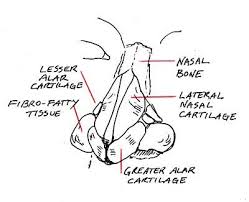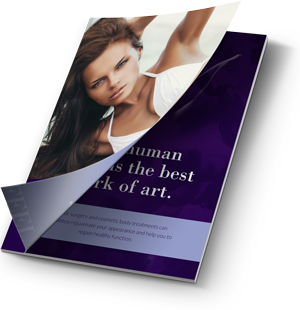San Diego Rhinoplasty | Nose Job Surgeon in San Diego
Rhinoplasty & Nose Surgery Specialist
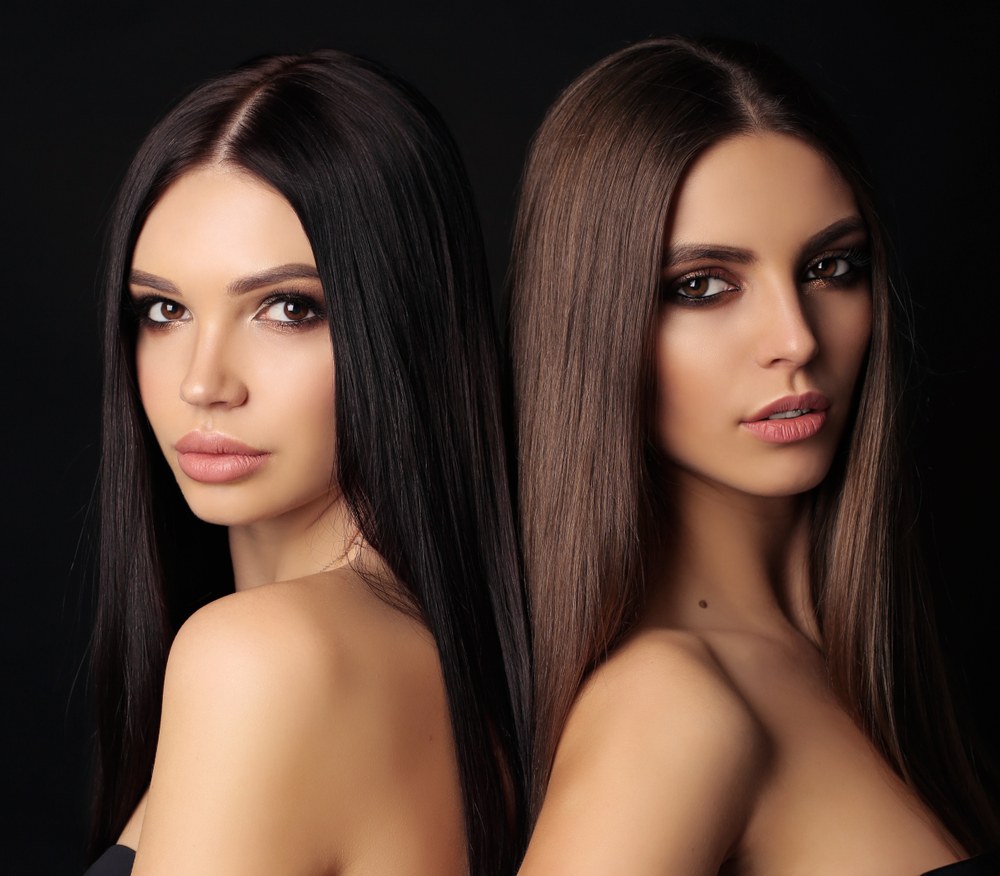
An Asian nose job is unique from other rhinoplasty procedures. Click on the button below to learn more
Rhinoplasty Information San Diego
Your nose is central on your face, and is an essence of your visual. Size, shape, and proportion are defining elements. Small millimeter adjustments produce dramatic differences. Precise refinements that beautify your face are Dr. Laverson’s specialty! Every person and each nose is unique. Your rhinoplasty procedure is planned and individualized to your specifications.
Steve Laverson, MD, FACS
- Diplomate, American Board of Surgery
- Diplomate, American Board of Plastic Surgery
- Member, American Society of Aesthetic Plastic Surgeons
- Member, American Society of Plastic Surgeons
Nose Job San Diego Information
Ethnic differences, skin type, and your preferences are important in planning your rhinoplasty
Although rhinoplasty is highly individualized, some changes are common. Feminizing the caucasian nose is achieved by diminishing size and more delicate contours. Lowering a bump on top of the nose, raising the tip, narrowing the bridge and/or nostrils, and adding subtle angularity to the tip of the nose are often part of the procedure. The relatively smaller nose enlarges surrounding eyes and lips.
Many present other requests, but a smaller nose with narrowed base, narrowed top of nose, straightening the nose, improved breathing, and delicate more angular tip of the nose are frequent changes.
For men, a strong, straight nose with well defined tip facets may be preferred.
What to Expect
The process begins with a meeting in our San Diego office or with a review of photos you send. We learn about and understand your vision and adjustments you want. Then, we simulate those changes on your profile photograph.
Dr. Laverson learns how you want your nose to appear. Besides lowering the bump on top of the nose, narrowing the nose, and refining the nasal tip, other possible changes are increasing or decreasing length and/or projection of the nose, raising the top of the nose with graft(s), narrowing and/or reshaping nostrils, and lowering or augmenting the root of the nose (between the eyes). Airway issues (obstruction with difficult breathing) may be addressed as well. Your rhinoplasty result may be simulated in our office with Canfield surgical simulation to help you visualize expected results. Even more valuable are Dr. Laverson’s hand drawn proposed profile changes. He uses your photos as a beginning, and sketches expected results on acetate overlay. You decide whether or not the planned changes are what you want. When you and Dr. Laverson come to agreement about what should be done, he uses the diagram as a guide during your rhinoplasty procedure to produce an outcome you’ll be pleased with. Schedule a free consultation in our San Diego location today.
Your wishes represent our directive for planning your rhinoplasty. Dr. Laverson will explain the technique to accomplish your desired changes, and what to expect. He may also suggest additional or alternative changes to maintain proportion with other features of your nose and face.
In the operating room, Dr. Laverson uses sophisticated instrumentation and materials for maximum control and precision in your rhinoplasty, including Mectron Piezosurgery®, Medtronic XPS Nexus® , Medpor® porous polyethylene implants, Musculoskeletal Transplant Foundation Biologics and more or others as indicated.
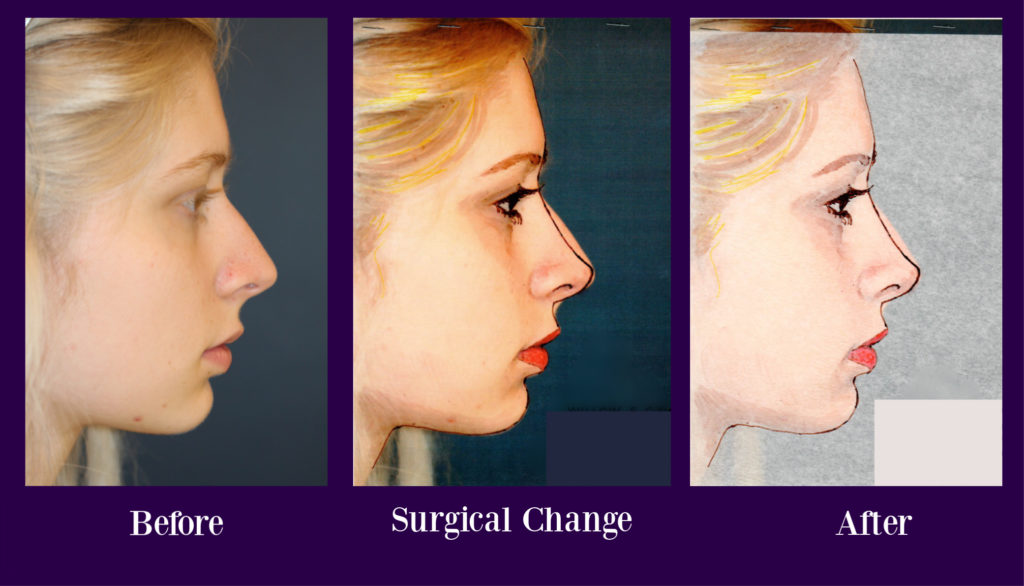
The Rhinoplasty Procedure
A Better Nose, A Better Life
Call Now! Book Your Consultation with a Double Board Certified Surgeon and Rhinoplasty Specialist
(858) 295-4001
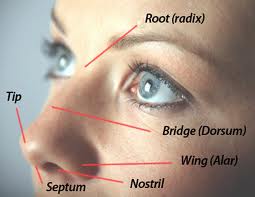
No two rhinoplasty surgeries are alike because no two noses are alike.
Even if two noses were identical, the patients behind those noses may want two different outcomes. Everyone’s face and skin are different as well. All these variables affect rhinoplasty plans and results. Dr. Laverson wants to deliver the best possible result for your situation. He plans and executes the rhinoplasty procedure accordingly.
Your nose is similar to a camping tent.
Tent poles inside support the fabric cover, determining shape and structure. Tent poles are like the nasal skeleton, consisting of bones in the upper nose and cartilage in the lower nose. Bone is rigid and cartilage is stiff, but flexible. Fabric covering of the tent is like skin over the nasal skeleton. Dr. Laverson changes shape of the nose by changing the underlying bony and cartilage skeleton, and overlying skin re-drapes over the new shape. Bone and cartilage structure of the nose are reduced by precision surgical techniques: filing/rasping, chiseling, removing, re-shaping, and re-assembling these skeletal parts. Deficient areas are augmented by grafting cartilage from inside the nose, your ear or rib, or by adding implant(s). Shape of the structures are changed by moving elements as needed and suturing them securely in their new position. Nasal skin conforms to the reshaped structure underneath, and that work of art is your new (beautiful) nose!
Read more about:
San Diego Rhinoplasty FAQs
Will rhinoplasty help me?
Many individuals consider rhinoplasty for one or more of the following:
- Your nose seems too large for your face
- There is a bump on the nasal bridge in profile view
your nose seems too long or too wide from the front view - Your nasal tip droops or plunges
- Your nasal tip is disproportionately large, poorly defined, and/or indistinct
- Your nostrils seem large and/or flared out to the sides
- Your nose appears irregular, off to one side, bent, or crooked
- Injury to the nose has produced visible irregularities
Rhinoplasty (cosmetic surgery of the nose) can reliably improve the above features. Schedule your own consultation. Describe to Dr. Laverson how you want your nose to look. If your expectations are reasonable, you will most likely be pleased with your result.
What is open rhinoplasty surgery
Because precision is critical, Dr. Laverson prefers open rhinoplasty technique. Performed in our fully accredited surgery center under general anesthesia, the open rhinoplasty approach allows direct visualization of all nasal structures, accurate evaluation of important details, and incremental adjustments until your desired appearance is achieved. Rhinoplasty is best accomplished by surgeons with an intuitive sense of proportion and excellent surgical skills. Dr. Laverson performs rhinoplasty under high quality optical magnification. The procedure is disciplined, and executed as planned in sequential steps. Like movements in a symphony, your result comes together during the course of a two to four hour operation. The board certified highly experienced anesthesiologist monitors your vital functions throughout, protecting you and assuring your safety and comfort. Splints are applied at the conclusion of rhinoplasty to stabilize structure during the first post-operative week. These are removed in our San Diego office, at which time you get your first inkling of the result. Like many aesthetic procedures, swelling persists for some time. Healing and contraction progress for many months. You can expect to look very presentable in 2-3 weeks, but your appearance continues to improve gradually. Dr. Laverson has a revision rate of about ten percent. These are most often minor adjustments desired by patients and accomplished in our San Diego office under local anesthesia at minimal cost to you.
How does Dr. Laverson evaluate me for rhinoplasty?
Brief questions about your medical history will be asked. Past and present illnesses, medications, surgery, treatments, and injuries to the nose should be disclosed. When you visit our San Diego office, the inside of your nose will be examined to check your airway and other features. Characteristics of your nasal skin, bone, and cartilage will be observed in the context of changes you request and other aspects of your face. Dr. Laverson will consider whether or not he agrees that your requested changes will improve the appearance of your nose and your face. If he does agree, he’ll explain the best technique to you, and associated risks. If he doesn’t agree, he’ll explain why, and make alternative recommendations. Dr. Laverson may advise placement of a chin implant during your procedure to improve proportion with the nose.
How much does rhinoplasty cost in San Diego?
The cost of of rhinoplasty in San Diego depends on the duration and complexity of your rhinoplasty, whether or not implants are used, and whether other procedures are accomplished under the same anesthetic. If only the tip is corrected, cost is less. If the nose is crooked and there are breathing problems, cost may be more. Price range including anesthesiologist, surgery center, and post-operative care six to twelve thousand dollars.
Will there be any scars from my rhinoplasty?
Visible scars from rhinoplasty are rare. Dr. Laverson performs rhinoplasty with bright surgical lighting and high quality optical magnification through an “open” technique for maximum precision. A tiny scar across the bottom skin bridge between your nostrils usually disappears over time. Stitches are removed after one week. Changes that Dr. Laverson can directly visualize through the open technique include lowering or raising the nasal bridge, diminishing size and refining definition of the tip, narrowing your nostrils, and changing angles to raise the tip of the nose or at the top of your nose where it joins the forehead.
If necessary, the base of your nose may be narrowed by removing small skin wedges at your nostril margins. This produces scars that are hidden, and become obscure or undetectable over time. Occasionally, if desired, an office procedure to improve the appearance of scars is indicated.
What are the risks?
Tens of thousands of rhinoplasties are performed around the world each year without complications. Still, problems may occur. If you are considering rhinoplasty, learn about possible complications in advance. Our informed consent document explaining common risks is HERE. Should a problem occur, Dr. Laverson will be beside you to continue your care until the problem is resolved with the best possible outcome.
How to prepare for rhinoplasty and your surgical experience
- If you smoke, stop at least three weeks before rhinoplasty.
- Do NOT take aspirin, Bayer, Excedrin, Ibuprofen, or any other anti-inflammatory medication for at least ten days before rhinoplasty. These increase bleeding and bruising, prolonging your recovery.
- Clear your calendar for the week following rhinoplasty.
- Arrange a ride home the day of surgery, and someone to stay with you overnight.
Your rhinoplasty will be performed at a fully accredited ambulatory surgery center in San Diego. Upon arrival at our San Diego surgery center, front desk staff asks you to complete documentation.
General Instructions to Follow Before & After Your Rhinoplasty Procedure >>
You change clothing and meet nursing staff in the pre-operative room. Your Anesthesiologist will meet and interview you briefly, and examine you, and Dr. Laverson will ask if you have last minute questions, concerns, requests, or reminders. You are then walked to the operating room with the nurse who stays in the operating room during your entire procedure. Dr. Laverson and the anesthesiologist will be there.
The anesthesiologist starts an intravenous line, wishes you pleasant dreams, and before you know it (there is no sense of time under anesthesia) you awake from surgery in the recovery room! After 60-90 minutes in recovery, you are usually awake enough to go home. The week following rhinoplasty is the most unpleasant time. There is a splint on top of your nose, so you won’t get to see the result right away. Splints inside your nose force you to breathe through your mouth, even while eating. For several days afterward, you may have post-nasal drip of blood and/or secretions. A “moustache” dressing beneath your nostrils may also help absorb drainage.
There will be swelling and bruising around the nose, visible beneath your eyes and on your cheeks. Bruising usually resolves in several days. Sleep with your head elevated on several pillows to minimize swelling of the nose and face. Take prescribed pain medicine as needed. At your one week follow up appointment with Dr. Laverson, splints and sutures are removed. This is not painful or uncomfortable. You will then get the first indication of your result, although still quite swollen. By two weeks after your procedure, swelling and bruising are further diminished, and most normal activities can be resumed.
When will I see the results of my rhinoplasty?
Rhinoplasty should produce a nose that looks natural and blends well with your other features. Because healing progresses slowly, plan to wait about one year for your final result. Still you’ll begin enjoying your new look two to four weeks after the procedure. If an area is imperfect, “touch up” revision can usually be accomplished in our San Diego office, and is much less extensive than the original procedure.
When can I resume normal activities?
Avoid straining, bending, and lifting during the week following surgery. Return to work is usually eight to ten days after rhinoplasty. Most normal activities including exercise are safely resumed three to six weeks after surgery. If the bones of your nose were moved, Dr. Laverson recommends supporting glasses with tape for two weeks to avoid pressure on healing nasal bones.
How long will the results last?
Rhinoplasty results are permanent, except for age associated changes and/or future trauma.
Do I need follow-up visits after rhinoplasty?
Long term follow-up visits in our San Diego office is an important part of your procedure, and will help you achieve your best result. Issues may only become apparent as swelling resolves by 6-12 months. At these times, your final result will be evaluated. Residual imperfections, if any, will be addressed. Even if your result seems perfect, Dr. Laverson needs to see you to understand the impact of each technical maneuver and of healing.
Revision Rhinoplasty. Contact Dr.Laverson for second medical opinion

Quality rhinoplasty outcomes demand from the surgeon an extraordinary level of technical skill and well developed aesthetic sense.
Preparation and experience are foundations for success, but intense study, in depth anatomical knowledge, and a passion for beauty are shared by most rhinoplasty specialists. Because every rhinoplasty involves rearrangement of skin, bone, cartilage, internal nasal lining, and because the final result depends so much on how these tissues interact with one another as healing progresses, outcomes can never be anticipated with complete accuracy.
Along with the surgeon, nature determines the final result, and nature is not always predictable. Many circumstances contribute to a disappointing rhinoplasty result. In some cases:
it’s inadequate preparation, misjudgment of the effect of a particular step of the procedure
failure to perform necessary steps, or other surgical error.
Swelling from anesthesia obscures the precise effect of certain parts during rhinoplasty. These effects become apparent only after months have passed and swelling is resolved.
Tissue contraction with scar development during healing may dramatically change an original rhinoplasty result. Cartilage is flexible, and bending during the post-surgical period may create asymmetries.
Occasionally, even when rhinoplasty goes well and the nose heals as expected, you may not be happy with the appearance of your new nose and its relationship to your other features. In these cases, revision rhinoplasty can be performed to repair and restructure the nose toward your desired result.
What is revision rhinoplasty?
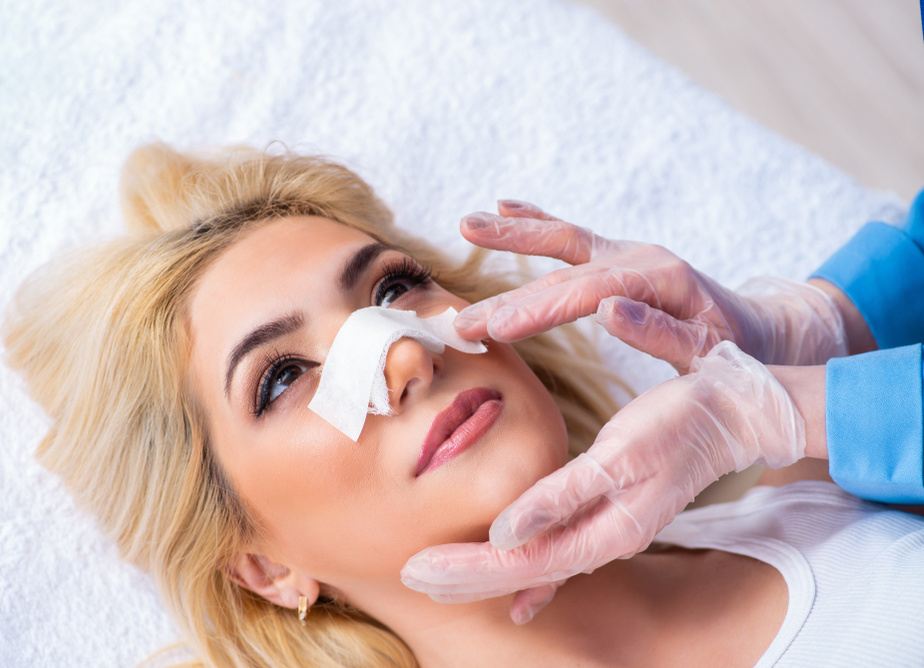
Working through scarred tissue to find and adjust parts of the nose during a revision procedure demands more of the surgeon. A determined, careful approach is required to fix problems unaddressed by or resulting from an earlier nose surgery. The procedure is different for everyone.
The specific techniques involved in each revision rhinoplasty are determined by the type of problem and the location in the nose.
A number of different factors can add to the complex nature of revision rhinoplasty, including:
- the previously altered anatomy of the nose
- weakened bones from the earlier surgery
- and missing cartilage or scarred cartilage.
When looking for a surgeon to perform revision rhinoplasty, it’s crucial to choose one with extensive rhinoplasty experience, a deep anatomical knowledge of the nose, an artistic eye, and superior surgical judgement.
The best revision rhinoplasty surgeon will also be a skilled and compassionate communicator, keeping you informed every step of the way so that you understand what to expect during and after the procedure.
What problems can be corrected with revision rhinoplasty?
- Common in cases involving the removal of a nose hump, pollybeak deformity is often the result of removing cartilage in the wrong areas, and not properly supporting the nasal tip. It can also be caused by leaving too much cartilage or a patient’s innate nasal skin surface area.
- A pinched tip can result from cutting cartilage or removing too much cartilage from the tip of the nose. A snout-like appearance can occur in the tip in cases of overshortening the nose during surgery. A lopsided tip may be the result of a surgical misjudgment or deviation during healing. A large tip may be related to failure of skin to contract around the diminutive surgically reduced tip cartilages.
Hump removal without properly reconstructed support and structure for the middle part of the nose can cause the valves to collapse inward, obstructing airflow and causing breathing problems.
- Notched nostrils, collapsed nostrils, asymmetric nostrils, and other nostril irregularities can be related to a pre-existing situation, or to skin and cartilage issues of tension or support created at the initial rhinoplasty.
A crooked nose after rhinoplasty sometimes occurs due to inaccurate alignment during surgery, but more often it happens when nasal bones or cartilage contract, bend, or shift during healing.
- Damage to the septum cartilage during surgery or the removal of too much septum cartilage can collapse the nasal bridge, resulting in a deformity known as saddle nose. Protracted cocaine use may cause the same problem. In cases of other surgical misfortune, other nasal deformities may occur.
Rhinoplasty Testimonials From Our San Diego Patients
Contact Us
Subscribe
Address:
Phone:
Business Hours:
Mon-Fri
9:00 AM to 5:00 PM

